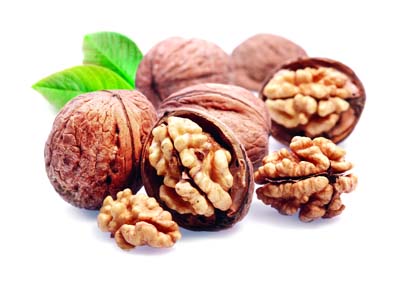Ancient Greeks noticed that walnuts appeared like human brains. Modern science says they are good for optimal brain function. Mark Bunn finds the connection
About 2,800 years ago, the ancient Greeks noticed that walnuts looked just like the human brain. Through the ancient science of observation, they saw that walnuts had distinct left and right hemispheres, wrinkles or folds just like our brain’s cerebral cortex, and were even contained in a hard shell just like our skull. Science now tells us that when eaten, a walnut’s active ingredients are able to cross our important blood-brain barrier and stimulate the production of important neurotransmitters, including serotonin, for optimal brain function. The oil in walnuts is also known to help break down plaque build-ups in our brain. Walnuts don’t just look like brains and provide nutrients such as healthy fatty acids, they specifically nourish our brain, memory and mental function.
Carrots, when cut, look just like the iris and pupil of an eye. Carrots don’t simply provide beta-carotene, traditionally they were known to nourish the eyes in an energetic and vibrational sense. Beetroots, which look just like red blood cells, don’t simply provide iron, they are known to specifically nourish our blood. Celery stalks aren’t just long and slender like human bones; celery also contains a similar percentage of bone-strengthening nutrients, such as sodium, to that found in human bones. Sweet potatoes don’t just resemble the pancreas. Despite their name, sweet potatoes are known to help balance blood sugars just like insulin, which is released from the pancreas. Thousands of years ago, American Indians noticed that a tomato and a human heart both possess a similar shape, colour and unique four hollow chamber design. Many nutritionists today suggest that tomatoes are good for the heart.
last but not least is the avocado. Avocadoes, when cut lengthwise into two halves, look like either a female womb and cervix or a pregnant female (the half with the seed intact). Avocadoes do far more than just supply some vitamin E or potassium. They were known traditionally to target the female organs of reproduction. This is why in ancient times the Mayans and Incas used to offer avocadoes to pregnant women as a gift to mother and baby. Interestingly, today’s science now suggests that avocadoes can help reduce cervical cancers, balance female hormones during pregnancy, and reduce unwanted birth weight after pregnancy. And how long does Mother Nature take to grow an avocado from blossom to ripened fruitIJ Nine months.
Male, female foods
According to Tolman, a further illustration of the inherent intelligence in whole foods is shown in the understanding of how different foods nourish men and women in different ways. While we are either male or female, according to ancient wisdom, each one of us is actually made up of both masculine and feminine qualities or energies. Similarly, all of Mother Nature’s foods were known to possess a predominantly female or male intelligence. Female foods were seen to be sweeter, more intuitive and could multi-task, while male foods could only be eaten one at a time, needed more regular washing, and went off quickly if not attended to! Seriously, foods that physically resemble the typical female body shape, the traditional pear shape, were known to predominantly nourish the feminine energy and female organs. Such foods include avocadoes, eggplant and pears themselves. Foods such as oranges, grape-fruits and other citrus fruits that look like female breasts are now known to assist the movement of lymph in and out of the breasts.
Some modern research has also begun to show associations between citrus fruits and breast cancer protection. Melons and coconuts, terms sometimes used derogatorily to describe female breasts due to their strong resemblance, were also known to nourish the breasts. In Ayurveda, coconut juice has long been considered par excellence for nourishing the female breast tissue, and similar juices are commonly prescribed for breastfeeding mothers, as they are known to directly nourish breast milk.
Conversely, foods resembling the primary male reproductive organ were believed to strengthen masculine energy (bananas, zucchinis, cucumbers) and stimulate male sexual energy (peanuts). Interestingly, arginine, an amino acid found in rich supply in peanuts, is today one of the main constituents of Viagra! ladies, beware a certain someone emptying the peanut bowl at your next party! Kiwi fruits and fresh figs, which grow in pairs of two, both look like male testicles and are full of ‘seeds’. Figs and kiwi fruits are thought to boost the motility, volume and health of sperm.
While from a modern, scientific perspective any of these correlations may be deemed less than categorical, it is good to appreciate that the law of similarities works at a far deeper level of nature’s wisdom than isolated nutritional components. It is the holistic effect of foods on the electrical energy pattern of the organs they target that delivers their ultimate nourishment. In this light, these examples and many more further point to the fundamental and unequivocal intelligence of Mother Nature’s whole foods.
One could ask, “What if I don’t know all the different food signaturesIJ” Fortunately, we don’t even need to know them in detail. Mother Nature always makes things simple. At a deep unconscious level, the fact that we find a certain fruit or vegetable’s smell, shape, colour or texture pleasing or desirable is a sign that it is balancing for us. If certain foods do not appeal, that can be a sign that our body may not need so much of that food at that time. Of course, this all depends on being in a state of relative balance. When we get stressed, our natural, intelligent desires for food can get distorted. If in doubt, just try to follow the signs.
The writer is a health expert based in Australia


























